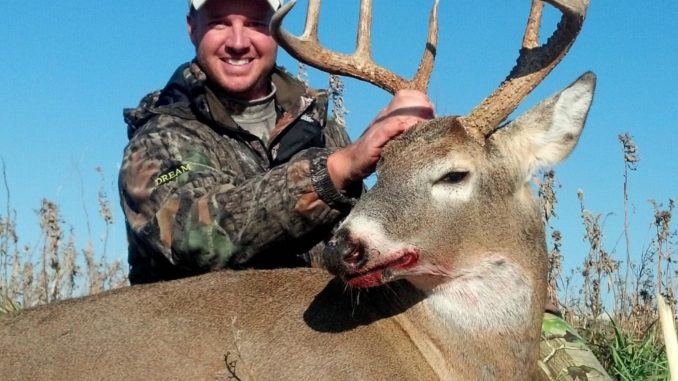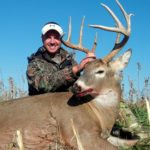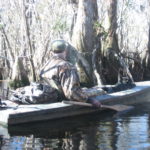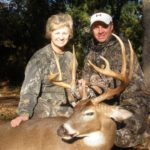
Find out-of-the-way water courses and find a big, late-season buck.
As the last month of the season arrives, hunters can still fill their last buck tag and make one last visit to the taxidermist, even though most of the immature and dim-witted bucks have learned about deer season the hard way. The surviving animals are well educated and unlikely to make the same mistakes their late relatives did.
Changes in food availability and hunting pressure will keep deer alert this time of year and in and around flooded places where a sense of security brews. But the educated hunter who doesn’t mind getting his feet wet can score big in the season’s final episode.
December is a unique time for the whitetail deer. The breeding season is coming to a close and food is beginning to look real good as winter weather makes its way into the Carolinas.
For the past two months, bucks have chased about every doe in the county trying to pass on their genetic material, and food has been nearly forgotten. With the exception of a few, the majority of does have been bred by Dec. 1, and the interest towards food moves back toward the top of the list as the last four weeks of the season tick down.
Unfortunately, deer are not in luck. The rich, natural food sources available a few weeks earlier have dried up or almost all been consumed by their brethren. Deer need to eat, however, and they will seek out solid food sources, including crops in agriculture fields, oak flats and remote food plots removed from hunting pressure. Areas consistently trampled by hunters over the past few months are true danger zones, and bucks will stay clear of them.
Evading dangerous encounters with hunters — and in eastern North Carolina, their hounds — can be extremely challenging for December deer. But the survivors have learned to move to natural water courses where protection is available from most dangers.
When it comes to water, deer are right at home. They can maneuver with ease in places inundated with water 6 inches to 6 feet deep. North Carolina is loaded with thousands of flooded acres where big bucks can retreat late in the season.
Richie Ward of Sanford has put his time in the deer woods for more than 30 years hunting across North Carolina’s Piedmont and costal plain, and all over Georgia, Alabama, Kentucky, Illinois, Iowa and Ohio. His deer stands are frequently close to some type of water throughout the year.
“In water, they can hear you and see you coming. They feel safe,” said Ward, who uses water as a beacon to set up his stands. “But it is more of a false sense of security in my mind. It is one of the first landmarks I locate when looking at unfamiliar territory.
“I always hunt on or around some type of water course, whether it is a river, stream or beaver pond, and these ponds sure can hold a lot of deer in the late season,” says Ward.
As the season progresses, escalating hunting pressure forces deer away from the typical places and deep into the thick cover associated with large beaver ponds and swamps, especially in the eastern part of the state.
“In the eastern counties where they can still run dogs, deer feel the pressure and head for the water,” Ward said.
But deer still need to eat, and there is little to eat over the winter months in the flooded swamp. So they will leave their water-logged security zones to fill up on corn, soybeans and tender wheat shoots. Ward likes to find them moving between their primary winter food sources and the nearest water course or a late-afternoon staging area.
“They will hold up on oak flats and make that last 100 yards to the fields right before dark, and that is where I catch them,” he said.
In order to find the best locations for his stands, Ward walks along the edges of streams, beaver ponds or swamps looking for high travel areas or places where tracks converge. He scouts these areas during the early season and during the middle of the day when deer are less likely to be using them.
Chad Weatherford of Loris, S.C., hunts recreationally in both North Carolina and South Carolina, and he encounters all types of terrain during the nationwide locations on the AWA Whitetail Pro Series tournament trail. He likes to use water that naturally funnels deer past his stand.
“Water creates pronounced pinch points between two bodies of water,” he said.
Ward will hunt along streams and rivers anytime during the rut to catch a buck looking for a receptive doe.
“Bucks will travel parallel to the waterways, frequently crossing the stream back and forth smelling for any signs of a doe in heat,” he said.
But beyond channeling the animals along a specified pathway, Weatherford believes traveling through the waterway increases his ability to slip into their backyard without causing a stir.
“It’s easier to get close to the deer without being detected,” he said, explaining that deer are spooked less by the sounds of sloshing water than rustling leaves; it is a more natural and less alarming sound. “Always strategize how you are going to make your approach. You can also use a kayak or small boat. It can be the most quiet and quickest way sometimes to get deep into their hiding places.”
One major benefit to hunting along waterways is the presence of thick vegetation that holds deer when the pressure is on. These swamps, streams and beaver ponds are associated with fertile soils and aggressive, shrubby vegetation that makes for a perfect safe haven. Even during periods of drought, these low-lying areas will stay moist, allowing for good plant growth.
Typically, giant switch cane grows along swamp edges and will become very dense. Weatherford keys in on these patches when he can and keeps a mental note of them when he is scouting throughout the year. He likes to hang a tree stand near these areas to overlook the trails entering and exiting.
“The reed patches are some of my favorites because deer will bed in them, and they will feel secure when they are around them,” he said.
These thick areas along waterways provide just about everything a deer needs, with the exception of food. Hunters can intercept them when they make their way to their evening dinner table on higher ground where late-season food sources remain available.
December may be viewed as a down time for hunters, but it shouldn’t be, especially in areas where there is significant flooded acreage — and just about every hunting property will have some. After months of extreme hunting pressure, deer will find places well away from the easy access of hunters. The bottom line is, deer flock to safe places this month, and hunters looking to fill another tag with a true wall hanger can make it happen in or around one of the many swamps, river bottoms and beaver ponds that pepper the landscape.







Be the first to comment